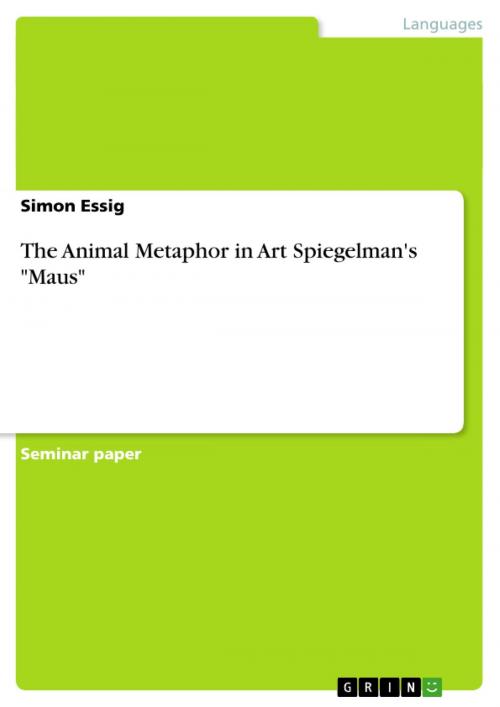The Animal Metaphor in Art Spiegelman's 'Maus'
Fiction & Literature, Literary Theory & Criticism, British| Author: | Simon Essig | ISBN: | 9783656721246 |
| Publisher: | GRIN Verlag | Publication: | August 19, 2014 |
| Imprint: | GRIN Verlag | Language: | English |
| Author: | Simon Essig |
| ISBN: | 9783656721246 |
| Publisher: | GRIN Verlag |
| Publication: | August 19, 2014 |
| Imprint: | GRIN Verlag |
| Language: | English |
Seminar paper from the year 2013 in the subject English - Literature, Works, grade: 1,0, University of Tubingen (Philosophische Fakultät), course: Popular Culture, language: English, abstract: Representing the Holocaust in a comic book is a daring enterprise; doing it with animal figures is even bolder. Spiegelman's work Maus braves many conventions of dealing with the Holocaust but reconstructs it in an unprecedented and unique manner. By exceeding literary boundaries and generic expectations, it is thus an essential addition to Holocaust literature. [...] This paper analyzes the animal metaphor in Spiegelman's Maus. It examines and discusses the different spheres in which the functions of the animal metaphor become evident. First, this paper traces back to the origins of using animals in literature. After a brief historical introduction of the sources and the development of animal figures, chapter 2 explains their literary function and their significance in comic books. Chapter 3 delivers a brief overview of Maus. It includes a synopsis of the comic's plot as well as a summary of its reception. Chapter 4, the main part of this paper, investigates the various functions and receptions of the animal metaphor in Maus from different perspectives. In chapter 4.1, Spiegelman's personal explanations reveal how Maus's animal characters function for him as a second generation witness. Chapter 4.2 focuses upon these implications brought into play with the use of the mask. A further subject, discussed in chapter 4.3, is how the animal imagery serves as a distancing and defamiliarizing device in order to deal with the horror of the Holocaust. Chapter 4.4 discusses the interconnection between both features. In chapter 4.5, the examination tries further to comprehend how the animal metaphor contributes to the reconstruction of ethnicity and identity in Maus. Since any analysis of a comic book must not neglect its visual dimension, chapter 4.6 considers Maus's drawing style and the significance of its visual representation. Maus has attracted many critics and its reception has been diverse and manifold. Target of the criticism has been especially the use of animals as substitutes for human beings. Chapter 4.7 examines and discusses Maus's animal device from a critical point of view regarding its incongruities and problems brought into play with the association of human beings and animals. The last chapter summarizes the insights of the analysis and discusses in what way Maus's animal metaphor strikes a new path in the conception and reconstruction of the Holocaust.
Seminar paper from the year 2013 in the subject English - Literature, Works, grade: 1,0, University of Tubingen (Philosophische Fakultät), course: Popular Culture, language: English, abstract: Representing the Holocaust in a comic book is a daring enterprise; doing it with animal figures is even bolder. Spiegelman's work Maus braves many conventions of dealing with the Holocaust but reconstructs it in an unprecedented and unique manner. By exceeding literary boundaries and generic expectations, it is thus an essential addition to Holocaust literature. [...] This paper analyzes the animal metaphor in Spiegelman's Maus. It examines and discusses the different spheres in which the functions of the animal metaphor become evident. First, this paper traces back to the origins of using animals in literature. After a brief historical introduction of the sources and the development of animal figures, chapter 2 explains their literary function and their significance in comic books. Chapter 3 delivers a brief overview of Maus. It includes a synopsis of the comic's plot as well as a summary of its reception. Chapter 4, the main part of this paper, investigates the various functions and receptions of the animal metaphor in Maus from different perspectives. In chapter 4.1, Spiegelman's personal explanations reveal how Maus's animal characters function for him as a second generation witness. Chapter 4.2 focuses upon these implications brought into play with the use of the mask. A further subject, discussed in chapter 4.3, is how the animal imagery serves as a distancing and defamiliarizing device in order to deal with the horror of the Holocaust. Chapter 4.4 discusses the interconnection between both features. In chapter 4.5, the examination tries further to comprehend how the animal metaphor contributes to the reconstruction of ethnicity and identity in Maus. Since any analysis of a comic book must not neglect its visual dimension, chapter 4.6 considers Maus's drawing style and the significance of its visual representation. Maus has attracted many critics and its reception has been diverse and manifold. Target of the criticism has been especially the use of animals as substitutes for human beings. Chapter 4.7 examines and discusses Maus's animal device from a critical point of view regarding its incongruities and problems brought into play with the association of human beings and animals. The last chapter summarizes the insights of the analysis and discusses in what way Maus's animal metaphor strikes a new path in the conception and reconstruction of the Holocaust.















